Impact of Gaseous Pollutants Reduction on Fine Particulate Matter and Its Secondary Inorganic Aerosols in Beijing–Tianjin–Hebei Region
Abstract
1. Introduction
2. Methodology
2.1. Model Configurations and Simulation Design
| Physical and Chemical Processes | Baseline Simulations |
|---|---|
| Simulation period | January 2016 |
| Domain | East Asia (36 km), northern China (12 km) |
| Vertical resolution | 23 layers from 1000 to 100 mb |
| Anthropogenic emissions | MEIC [http://www.meicmodel.org/; accessed on 25 April 2023] |
| Biogenic emissions | MEGAN 2 [48] |
| Dust emissions | GOCART dust emissions [50] |
| Sea-salt emissions | Gong [2003] [51] |
| Meteorological ICs and BCs | The National Centers for Environmental Prediction Final Analysis (NCEP-FNL) reanalysis data |
| Chemical IC and BC | Default for 36-km; nested down from the parent domain for 12-km |
| Gas-phase chemistry | SAPRC-99 [38] |
| Photolysis | Madronich F-TUV [40] |
| Aerosol module | 4-bin MOSAIC aerosol with volatility basis set (VBS) [39,52] |
| Urban surface | Urban canopy model [53,54] |
| Shortwave radiation | RRTMG [41] |
| Longwave radiation | RRTMG [41] |
| Land surface | NOAH Land Surface Model [43,44] |
| Surface layer | Monin–Obukhov [55,56] |
| PBL | Yonsei University Scheme (YSU) [57] |
| Cumulus | Grell 3D ensemble [58] |
| Microphysics | Morrison double-moment [42] |
2.2. Scenarios Setting in Air Quality Model and Real-Time Monitoring Data
3. Results
3.1. Quality Assurance (QA) and Quality Control (QC) in 36 km and 12 km
3.1.1. QA and QC in 36 km
3.1.2. QA and QC in 12 km
3.2. Determination of NH3-Rich Region in BTH Region
3.3. Source Contribution of PM2.5 in Different Scenarios in BTH Region
3.4. Impact of Gaseous Emission Reduction on Secondary Inorganic Aerosol in PM2.5
3.4.1. Impact of Emission Reduction in BTH Region on NH4+, SO42−, and NH4+
3.4.2. Sensitivity of Emission Reduction to NH4+, SO42−, and NH4+ in Different Scenarios
3.5. Impact of Emission Reduction in BTH Region on Size Distribution of Secondary Inorganic Aerosol
3.5.1. Impact on Size Distribution of NH4+, SO42−, and NH4+ in BTH Region
3.5.2. Sensitivity of Emission Reduction to NH4+, SO42−, and NH4+ in Different Cities
4. Discussion
5. Conclusions
Author Contributions
Funding
Institutional Review Board Statement
Informed Consent Statement
Data Availability Statement
Conflicts of Interest
References
- Donaldson, K.; Li, X.Y.; Macnee, W. Ultrafine (nanometre) particle mediated lung injury. J. Aerosol Sci. 1998, 29, 553–560. [Google Scholar] [CrossRef]
- Tao, J.; Ho, K.F.; Chen, L.G.; Zhu, L.H.; Han, J.L.; Xu, Z.C. Effect of chemical composition of PM2.5 on visibility in Guangzhou, China, 2007 spring. Particuology 2009, 7, 68–75. [Google Scholar] [CrossRef]
- Pui, D.Y.H.; Chen, S.C.; Zuo, Z.L. PM2.5 in China: Measurements, Sources, visibility and health effects, and mitigation. Particuology 2014, 13, 1–26. [Google Scholar] [CrossRef]
- Pope, C.A., III; Burnett, R.T.; Thun, M.J.; Calle, E.E.; Krewski, D.; Ito, K.; Thurston, G.D. Lung cancer, cardiopulmonary mortality, and long-term exposure to fine particulate air pollution. J. Am. Med. Assoc. 2002, 287, 1132–1141. [Google Scholar] [CrossRef] [PubMed]
- Maria, S.F.; Russell, L.M.; Gilles, M.K.; Myneni, S.C.B. Organic aerosol growth mechanism and their climate-forcing implications. Science 2004, 306, 1921–1924. [Google Scholar] [CrossRef]
- Ramanathan, V.; Feng, Y. Air pollution, greenhouse gases and climate change: Global and regional perspectives. Atmos. Environ. 2009, 43, 37–50. [Google Scholar] [CrossRef]
- Zhang, X.Y.; Wang, Y.Q.; Niu, T.; Zhang, X.C.; Gong, S.L.; Zhang, Y.M.; Sun, J.Y. Atmospheric aerosol compositions in China: Spatial/temporal variability, chemical signature, regional haze distribution and comparisons with global aerosols. Atmos. Chem. Phys. 2012, 12, 779–799. [Google Scholar] [CrossRef]
- Cheng, Z.; Wang, S.X.; Jiang, J.K.; Fu, Q.Y.; Chen, C.H.; Xu, B.Y.; Yu, J.Q.; Hao, J.M. Longterm trend of haze pollution and impact of particulate matter in the Yangtze River Delta, China. Environ. Pollut. 2013, 182, 101–110. [Google Scholar] [CrossRef]
- Tao, J.; Gao, J.; Zhang, L.; Zhang, R.; Che, H.; Zhang, Z.; Lin, Z.; Jing, J.; Cao, J.; Hsu, S.C. PM2.5 pollution in a megacity of southwest China: Source apportionment and implication. Atmos. Chem. Phys. 2014, 14, 8679–8699. [Google Scholar] [CrossRef]
- Tan, J.H.; Duan, J.C.; Zhen, N.J.; He, K.B.; Hao, J.M. Chemical characteristics and source of size-fractionated atmospheric particle in haze episode in Beijing. Atmos. Res. 2016, 167, 24–33. [Google Scholar] [CrossRef]
- Tao, J.; Zhang, L.; Cao, J.; Zhang, R. A review of current knowledge concerning PM2.5 chemical composition, aerosol optical properties and their relationships across China. Atmos. Chem. Phys. 2017, 17, 9485–9518. [Google Scholar] [CrossRef]
- Wang, H.; Xu, J.Y.; Zhang, M.; Yang, Y.Q.; Shen, X.J.; Wang, Y.Q.; Chen, D.; Guo, J.P. A study of the meteorological causes of a prolonged and severe haze episode in January 2013 over central-eastern China. Atmos. Environ. 2014, 98, 146–157. [Google Scholar] [CrossRef]
- Wang, L.T.; Wei, Z.; Yang, J.; Zhang, Y.; Zhang, F.F.; Su, J.; Meng, C.C.; Zhang, Q. The 2013 severe haze over southern Hebei, China: Model evaluation, source apportionment, and policy implications. Atmos. Chem. Phys. 2014, 14, 3151–3173. [Google Scholar] [CrossRef]
- Wang, Y.S.; Yao, L.; Wang, L.L.; Liu, Z.R.; Ji, D.S.; Tang, G.Q.; Zhang, J.K.; Sun, Y.; Hu, B.; Xin, J.Y. Mechanism for the formation of the January 2013 heavy haze pollution episode over central and eastern China. Sci. China Earth Sci. 2014, 57, 14–25. [Google Scholar] [CrossRef]
- Zheng, B.; Zhang, Q.; Zhang, Y.; He, K.B.; Wang, K.; Zheng, G.J.; Duan, F.K.; Ma, Y.L.; Kimoto, T. Heterogeneous chemistry: A mechanism missing in current models to explain secondary inorganic aerosol formation during the January 2013 haze episode in North China. Atmos. Chem. Phys. 2015, 15, 2031–2049. [Google Scholar] [CrossRef]
- Zhai, S.X.; Jacob, D.J.; Wang, X.; Shen, L.; Li, K.; Zhang, Y.Z.; Gui, K.; Zhao, T.L.; Liao, H. Fine particulate matter (PM2.5) trends in China, 2013–2018: Separating contributions from anthropogenic emissions and meteorology. Atmos. Chem. Phys. 2019, 19, 11031–11041. [Google Scholar] [CrossRef]
- Kulmala, M.; Laaksonen, A.; Pirjola, L. Parameterizations for sulfuric acid/water nucleation rates. J. Geophys. Res. Atmos. 1998, 103, 8301–8307. [Google Scholar] [CrossRef]
- Korhonen, P.; Kulmala, M.; Laaksonen, A.; Viisanen, Y.; McGraw, R.; Seinfeld, J.H. Ternary nucleation of H2SO4, NH3, and H2O in the atmosphere. J. Geophys. Res. Atmos. 1999, 104, 26349–26353. [Google Scholar] [CrossRef]
- Birmili, W.; Wiedensohler, A. New particle formation in the continental boundary layer: Meteorological and gas phase parameter influence. Geophys. Res. Lett. 2000, 27, 3325–3328. [Google Scholar] [CrossRef]
- Kulmala, M.; Vehkamäki, H.; Petäjä, T.; Dal Maso, M.; Lauri, A.; Kerminen, V.M.; McMurry, P.H. Formation and growth rates of ultrafine atmospheric particles: A review of observations. J. Aerosol Sci. 2004, 35, 143–176. [Google Scholar] [CrossRef]
- Boy, M.; Karl, T.; Turnipseed, A.; Mauldin, R.L.; Kosciuch, E.; Greenberg, J.; Rathbone, J.; Smith, J.; Held, A.; Barsanti, K.; et al. New particle formation in the Front Range of the Colorado Rocky Mountains. Atmos. Chem. Phys. 2008, 8, 1577–1590. [Google Scholar] [CrossRef]
- Westerhoff, P.; Aiken, G.; Amy, G.; Debroux, J. Relationships between the structure of natural organic matter and its reactivity towards molecular ozone and hydroxyl radicals. Water Res. 1999, 33, 2265–2276. [Google Scholar] [CrossRef]
- Mauldin, R.L., III; Berndt, T.; Sipilä, M.; Paasonen, P.; Petäjä, T.; Kim, S.; Kurtén, T.; Stratmann, F.; Kerminen, V.M.; Kulmala, M. A new atmospherically relevant oxidant of sulphur dioxide. Nature 2012, 488, 193–196. [Google Scholar] [CrossRef] [PubMed]
- Chen, T.Z.; Chu, B.W.; Ge, Y.L.; Zhang, S.P.; Ma, Q.X.; He, H.; Li, S.M. Enhancement of aqueous sulfate formation by the coexistence of NO2/NH3 under high ionic strengths in aerosol water. Environ. Pollut. 2019, 252, 236–244. [Google Scholar] [CrossRef]
- Wang, S.Y.; Du, L.; Tsona, N.T.; Tsona, N.T.; Jiang, X.T.; You, B.; Xu, L.; Yang, Z.M.; Wang, W.X. Effect of NOx and SO2 on the photooxidation of methylglyoxal: Implications in secondary aerosol formation. J. Environ. Sci. 2020, 92, 151–162. [Google Scholar] [CrossRef]
- Sun, Y.H.; Chen, X.X.; Liu, L.; Xu, F.; Zhang, X.C. Mechanisms and Kinetics Studies of the Atmospheric Oxidation of Eugenol by Hydroxyl radicals and Ozone molecules. Sci. Total Environ. 2021, 770, 145203. [Google Scholar] [CrossRef]
- Tian, M.; Liu, Y.; Yang, F.M.; Zhang, L.M.; Peng, C.; Chen, Y.; Shi, G.M.; Wang, H.B.; Luo, B.; Jiang, C.T.; et al. Increasing importance of nitrate formation for heavy aerosol pollution in two megacities in Sichuan Basin, southwest China. Environ. Pollut. 2019, 250, 898–905. [Google Scholar] [CrossRef]
- Kulmala, M.; Pirjola, L.; Mäkelä, J.M. Stable sulphate clusters as a source of new atmospheric particles. Nature 2000, 404, 66–69. [Google Scholar] [CrossRef]
- Pozzer, A.; Tsimpidi, A.P.; Karydis, V.A.; de Meij, A.; Lelieveld, J. Impact of agricultural emission reductions on fine-particulate matter and public health. Atmos. Chem. Phys. 2017, 17, 12813–12826. [Google Scholar] [CrossRef]
- An, Z.S.; Huang, R.J.; Zhang, R.Y.; Tie, X.X.; Li, G.H.; Cao, J.J.; Zhou, W.J.; Shi, Z.G.; Han, Y.M.; Gu, Z.L.; et al. Severe haze in northern China: A synergy of anthropogenic emissions and atmospheric processes. Proc. Natl. Acad. Sci. USA 2019, 116, 8657–8666. [Google Scholar] [CrossRef]
- Xu, Z.Y.; Liu, M.X.; Zhang, M.S.; Song, Y.; Wang, S.X.; Zhang, L.; Xu, T.T.; Wang, T.T.; Yan, C.Q.; Zhou, T.; et al. High efficiency of livestock ammonia emission controls in alleviating particulate nitrate during a severe winter haze episode in northern China. Atmos. Chem. Phys. 2019, 19, 5605–5613. [Google Scholar] [CrossRef]
- Xu, J.; Chen, J.; Zhao, N.; Wang, G.C.; Yu, G.Y.; Li, H.; Huo, J.T.; Lin, Y.F.; Fu, Q.Y.; Guo, H.Y.; et al. Importance of gas-particle partitioning of ammonia in haze formation in the rural agricultural environment. Atmos. Chem. Phys. 2020, 20, 7259–7269. [Google Scholar] [CrossRef]
- Chen, D.S.; Yang, N.; Zhou, Y.; Lang, J.L.; Wang, X.T. Impact of ammonia emission on the formation of the secondary inorganic aerosol in winter in a typical area in North China. J. Saf. Environ. 2017, 17, 1129–1135. [Google Scholar]
- Pinder, R.W.; Adams, P.J.; Pandis, S.N. Ammonia emission controls as a cost-effective strategy for reducing atmospheric particulate matter in the eastern United States. Environ. Sci. Technol. 2007, 41, 380–386. [Google Scholar] [CrossRef] [PubMed]
- Liu, M.; Huang, X.; Song, Y.; Tang, J.; Cao, J.J.; Zhang, X.Y.; Zhang, Q.; Wang, S.X.; Xu, T.T.; Kang, L.; et al. Ammonia emission control in China would mitigate haze pollution and nitrogen deposition, but worsen acid rain. Proc. Natl. Acad. Sci. USA 2019, 116, 7760–7765. [Google Scholar] [CrossRef]
- Cai, C.J.; Zhang, X.; Wang, K.; Zhang, Y.; Wang, L.T.; Zhang, Q.; Duan, F.K.; He, K.B.; Yu, S.C. Incorporation of new particle formation and early growth treatments into WRF/Chem: Model improvement, evaluation, and impacts of anthropogenic aerosols over East Asia. Atmos. Environ. 2016, 124, 262–284. [Google Scholar] [CrossRef]
- Wang, L.T.; Fu, J.S.; Wei, W.; Wei, Z.; Meng, C.C.; Ma, S.M.; Wang, J.D. How aerosol direct effects influence the source contributions to PM2.5 concentrations over Southern Hebei, China in severe winter haze episodes. Front. Environ. Sci. Eng. 2018, 12, 1–13. [Google Scholar] [CrossRef]
- Carter, W.P.L. Implementation of the SAPRC99 Chemical Mechanism into the Models-3 Framework; Report to the U.S. EPA; Statewide Air Pollution Research Center, University of California: Riverside, CA, USA, 2000. [Google Scholar]
- Zaveri, R.A.; Easter, R.C.; Fast, J.D.; Peters, L.K. Model for simulating aerosol interactions and chemistry (MOSAIC). J. Geophys. Res. Atmos. 2008, 113, D13204. [Google Scholar] [CrossRef]
- Madronich, S.S.; Flocke, S. The role of solar radiation in atmospheric chemistry. Environ. Photochem. 1999, 2, 1–26. [Google Scholar]
- Iacono, M.J.; Delamere, J.S.; Mlawer, E.J.; Shephard, M.W.; Clough, S.A.; Collins, W.D. Radiative forcing by long-lived greenhouse gases: Calculations with the AER radiative transfer models. J. Geophys. Res. Atmos. 2008, 113, D13103. [Google Scholar] [CrossRef]
- Morrison, H.; Thompson, G.; Tatarskii, V. Impact of cloud microphysics on the development of trailing stratiform precipitation in a simulated squall line: Comparison of one and two moment schemes. Mon. Weather Rev. 2009, 137, 991–1007. [Google Scholar] [CrossRef]
- Chen, F.; Dudhia, J. Coupling an advanced land surface-hydrology model with the Penn State NCAR MM5 modeling system. Part I: Model implementation and sensitivity. Mon. Weather Rev. 2001, 129, 569–585. [Google Scholar] [CrossRef]
- Ek, M.B.; Mitchell, K.B.; Lin, Y.; Rogers, B.; Grunmann, P.; Koren, V.; Gayno, G.; Tarpley, J.D. Implementation of Noah land surface model advances in the National Centers for Environmental Prediction operational mesoscale Eta model. J. Geophys. Res. 2003, 108, 8851. [Google Scholar] [CrossRef]
- Wang, L.T.; Zhang, Y.; Wang, K.; Zheng, B.; Zhang, Q.; Wei, W. Application of Weather Research and Forecasting Model with Chemistry (WRF/Chem) over northern China: Sensitivity study, comparative evaluation, and policy implications. Atmos. Environ. 2016, 124, 337–350. [Google Scholar] [CrossRef]
- Li, M.; Liu, H.; Geng, G.N.; Hong, C.P.; Liu, F.; Song, Y.; Tong, D.; Zheng, B.; Cui, H.Y.; Man, H.Y.; et al. Anthropogenic emission inventories in China: A review. Natl. Sci. Rev. 2017, 4, 834–866. [Google Scholar] [CrossRef]
- Zheng, B.; Tong, D.; Li, M.; Liu, F.; Hong, C.P.; Geng, G.N.; Li, H.Y.; Li, X.; Peng, L.Q.; Qi, J.; et al. Trends in China’s anthropogenic emissions since 2010 as the consequence of clean air actions. Atmos. Chem. Phys. 2018, 18, 14095–14111. [Google Scholar] [CrossRef]
- Guenther, A.; Karl, T.; Harley, P.; Wiedinmyer, C.; Palmer, P.I.; Geron, C. Estimates of global terrestrial isoprene emissions using MEGAN (Model of Emissions of Gases and Aerosols from Nature). Atmos. Chem. Phys. 2006, 6, 3181–3210. [Google Scholar] [CrossRef]
- Guenther, A.B.; Jiang, X.; Heald, C.L.; Sakulyanontvittaya, T.; Duhl, T.; Emmons, L.K.; Wang, X. The Model of Emissions of Gases and Aerosols from Nature version 2.1 (MEGAN2.1): An extended and updated framework for modeling biogenic emissions. Geosci. Model Dev. 2012, 5, 1471–1492. [Google Scholar] [CrossRef]
- Ginoux, P.; Chin, M.; Tegen, I.; Prospero, J.M.; Holben, B.; Dubovik, O.; Lin, S.J. Sources and global distributions of dust aerosols simulated with the GOCART model. J. Geophys. Res. 2001, 106, 20255–20273. [Google Scholar] [CrossRef]
- Gong, S.L. A parameterization of sea-salt aerosol source function for sub and super-micron particles. Glob. Biogeochem. Cycles 2003, 17, 1097. [Google Scholar] [CrossRef]
- Shrivastava, M.; Fast, J.; Easter, R.; Gustafson, W.I., Jr.; Zaveri, R.A.; Jimenez, J.L.; Saide, P.; Hodzic, A. Modeling organic aerosols in a megacity: Comparison of simple and complex representations of the volatility basis set approach. Atmos. Chem. Phys. 2011, 11, 6639–6662. [Google Scholar] [CrossRef]
- Kusaka, H.; Kimura, F. Thermal effects of urban canyon structure on the nocturnal heat island: Numerical experiment using a mesoscale model coupled with and urban canopy model. J. Appl. Meteorol. Climatol. 2004, 43, 1899–1910. [Google Scholar] [CrossRef]
- Ikeda, R.; Kusaka, H. Proposing the simplification of the multilayer urban canopy model: Intercomparison study of four models. J. Appl. Meteorol. Climatol. 2010, 49, 902–919. [Google Scholar] [CrossRef]
- Monin, A.S.; Obukhov, A.M. Basic laws of turbulent mixing in the surface layer of the atmosphere. Contrib.Geo-Phys. Inst. Acad. Sci. 1954, 151, 163–187. (In Russian) [Google Scholar]
- Janić, Z.I. Nonsingular Implementation of the Mellor-Yamada Level 2.5 Scheme in the NCEP Meso Model; National Oceanic and Atmospheric Administration: Washington, DC, USA, 2001. [Google Scholar]
- Hong, S.S.; Noh, Y.; Dudhia, J. A new vertical diffusion package with an explicit treatment of entrainment processes. Mon. Weather Rev. 2006, 134, 2318–2341. [Google Scholar] [CrossRef]
- Grell, G.A.; Dévényi, D. A generalized approach to parameterizing convection combining ensemble and data assimilation techniques. Geophys. Res. Lett. 2002, 29, 1693. [Google Scholar] [CrossRef]
- Zhang, Y.; Liu, P.; Pun, B.; Seigneur, C. A comprehensive performance evaluation of MM5-CMAQ for the Summer 1999 Southern Oxidants Study episode—Part I: Evaluation protocols, databases, and meteorological predictions. Atmos. Environ. 2006, 40, 4825–4838. [Google Scholar] [CrossRef]
- Emery, C.; Liu, Z.; Russell, A.G.; Talat Odman, M.; Yarwood, G.; Kumar, N. Recommendations on statistics and benchmarks to assess photochemical model performance. J. Air Waste Manag. Assoc. 2017, 67, 582–598. [Google Scholar] [CrossRef] [PubMed]
- Zhang, Q.Q.; Pan, Y.P.; He, Y.X.; Zhao, Y.H.; Zhu, L.Y.; Zhang, X.Y.; Xu, X.J.; Ji, D.S.; Gao, J.; Tian, S.L.; et al. Bias in ammonia emission inventory and implications on emission control of nitrogen oxides over North China Plain. Atmos. Environ. 2019, 214, 116869. [Google Scholar] [CrossRef]
- Xu, G.Y.; Zhang, Q.Q.; Yao, Y.; Zhang, X.Y. Changes in PM2.5 sensitivity to NOx and NH3 emissions due to a large decrease in SO2 emissions from 2013 to 2018. Atmos. Ocean. Sci. Lett. 2020, 13, 210–215. [Google Scholar] [CrossRef]
- Wang, Y.; Xue, Y.F.; Tian, H.Z.; Gao, J.; Chen, Y.; Zhu, C.Y.; Liu, H.J.; Wang, K.; Hua, S.B.; Liu, S.H.; et al. Effectiveness of temporary control measures for lowering PM2.5 pollution in Beijing and the implications. Atmos. Environ. 2017, 157, 75–83. [Google Scholar] [CrossRef]
- Kwok RH, F.; Napelenok, S.L.; Baker, K.R. Implementation and evaluation of PM2.5 source contribution analysis in a photochemical model. Atmos. Environ. 2013, 80, 398–407. [Google Scholar] [CrossRef]
- Lu, D.B.; Mao, W.L.; Xiao, W.; Zhang, L. Non-linear response of PM2.5 pollution to land use change in China. Remote Sens. 2021, 13, 1612. [Google Scholar] [CrossRef]
- Stelson, A.W.; Seinfeld, J.H. Thermodynamic prediction of the water activity, NH4NO3 dissociation constant, density and refractive index for the NH4NO3-(NH4) 2SO4-H2O system at 25 °C. Atmos. Environ. (1967) 1982, 16, 2507–2514. [Google Scholar] [CrossRef]
- Cheng, L.; Ye, Z.L.; Cheng, S.Y.; Guo, X.R. Agricultural ammonia emissions and its impact on PM2.5 concentrations in the Beijing–Tianjin–Hebei region from 2000 to 2018. Environ. Pollut. 2021, 291, 118162. [Google Scholar] [CrossRef] [PubMed]
- Lin, Y.C.; Zhang, Y.L.; Fan, M.Y.; Bao, M.Y. Heterogeneous formation of particulate nitrate under ammonium-rich regimes during the high-PM2.5 events in Nanjing, China. Atmos. Chem. Phys. 2020, 20, 3999–4011. [Google Scholar] [CrossRef]
- Wexler, A.S.; Seinfeld, J.H. Analysis of aerosol ammonium nitrate: Departures from equilibrium during SCAQS. Atmospheric Environment. Part A Gen. Top. 1992, 26, 579–591. [Google Scholar] [CrossRef]
- Zhai, S.X.; Jacob, D.J.; Shah, V.; Yang, L.H.; Zhang, Q.; Sun, Y.L.; Wang, S.X.; Luo, G.; Yu, F.Q.; Woo, J.H.; et al. Coarse particulate matter air quality in East Asia: Implications for fine particulate nitrate. Atmos. Chem. Phys. 2023, 23, 4271–4281. [Google Scholar] [CrossRef]
- Fu, X.; Wang, T.; Gao, J.; Wang, P.; Liu, Y.M.; Wang, S.X.; Zhao, B.; Xue, L.K. Persistent heavy winter nitrate pollution driven by increased photochemical oxidants in northern China. Environ. Sci. Technol. 2020, 54, 3881–3889. [Google Scholar] [CrossRef]
- Zhai, S.X.; Jacob, D.J.; Wang, X.; Liu, Z.R.; Wen, T.X.; Shah, V.; Li, K.; Moch, J.M.; Bates, K.H.; Song, S.J.; et al. Control of particulate nitrate air pollution in China. Nat. Geosci. 2021, 14, 389–395. [Google Scholar] [CrossRef]
- Ye, Z.L.; Guo, X.R.; Cheng, L.; Cheng, S.Y.; Chen, D.S.; Wang, W.L.; Liu, B. Reducing PM2.5 and secondary inorganic aerosols by agricultural ammonia emission mitigation within the Beijing-Tianjin-Hebei region, China. Atmos. Environ. 2019, 219, 116989. [Google Scholar] [CrossRef]
- Clappier, A.; Thunis, P.; Beekmann, M.; Putaud, J.P.; de Meij, A. Impact of SOx, NOx and NH3 emission reductions on PM2.5 concentrations across Europe: Hints for future measure development. Environ. Int. 2021, 156, 106699. [Google Scholar] [CrossRef] [PubMed]



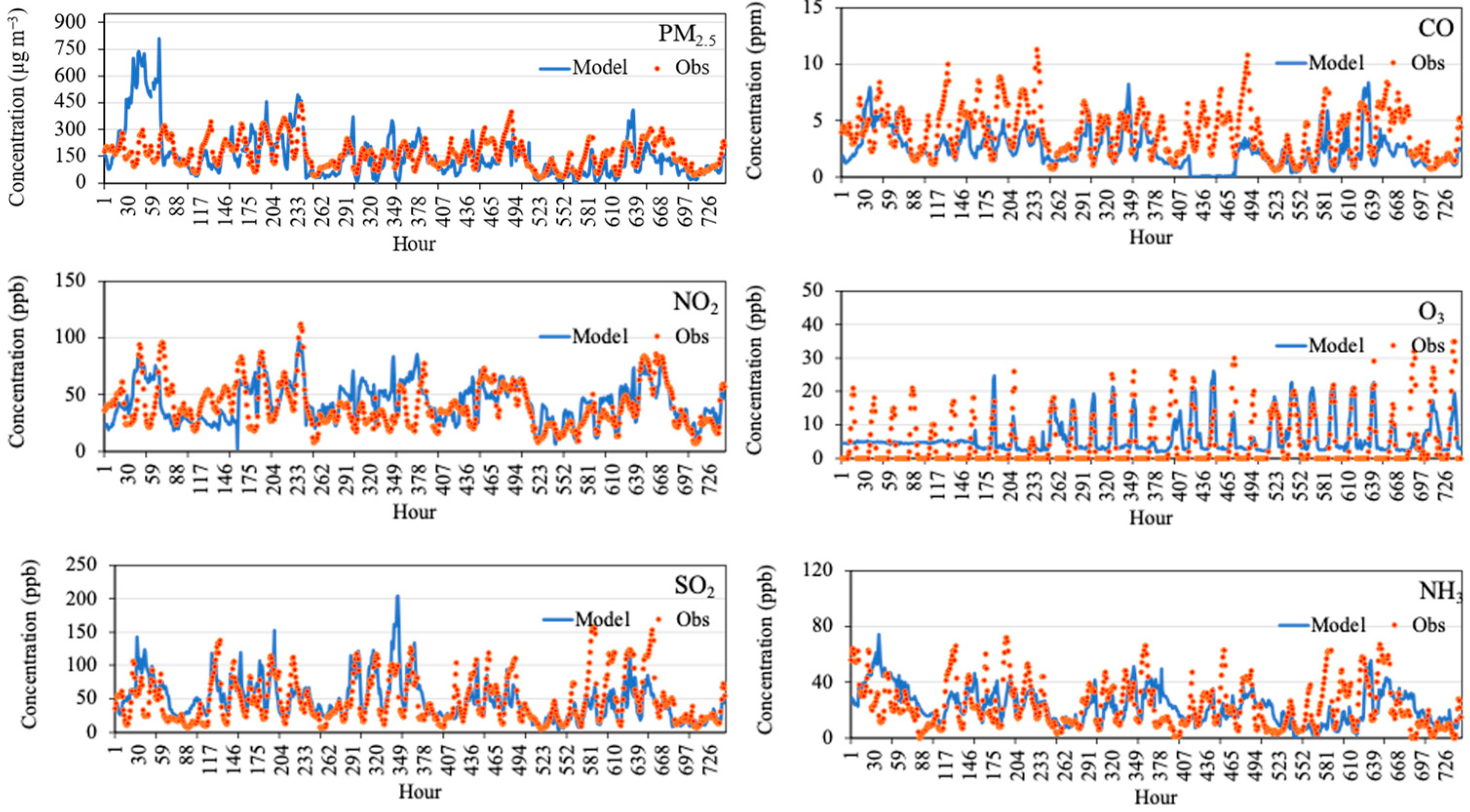
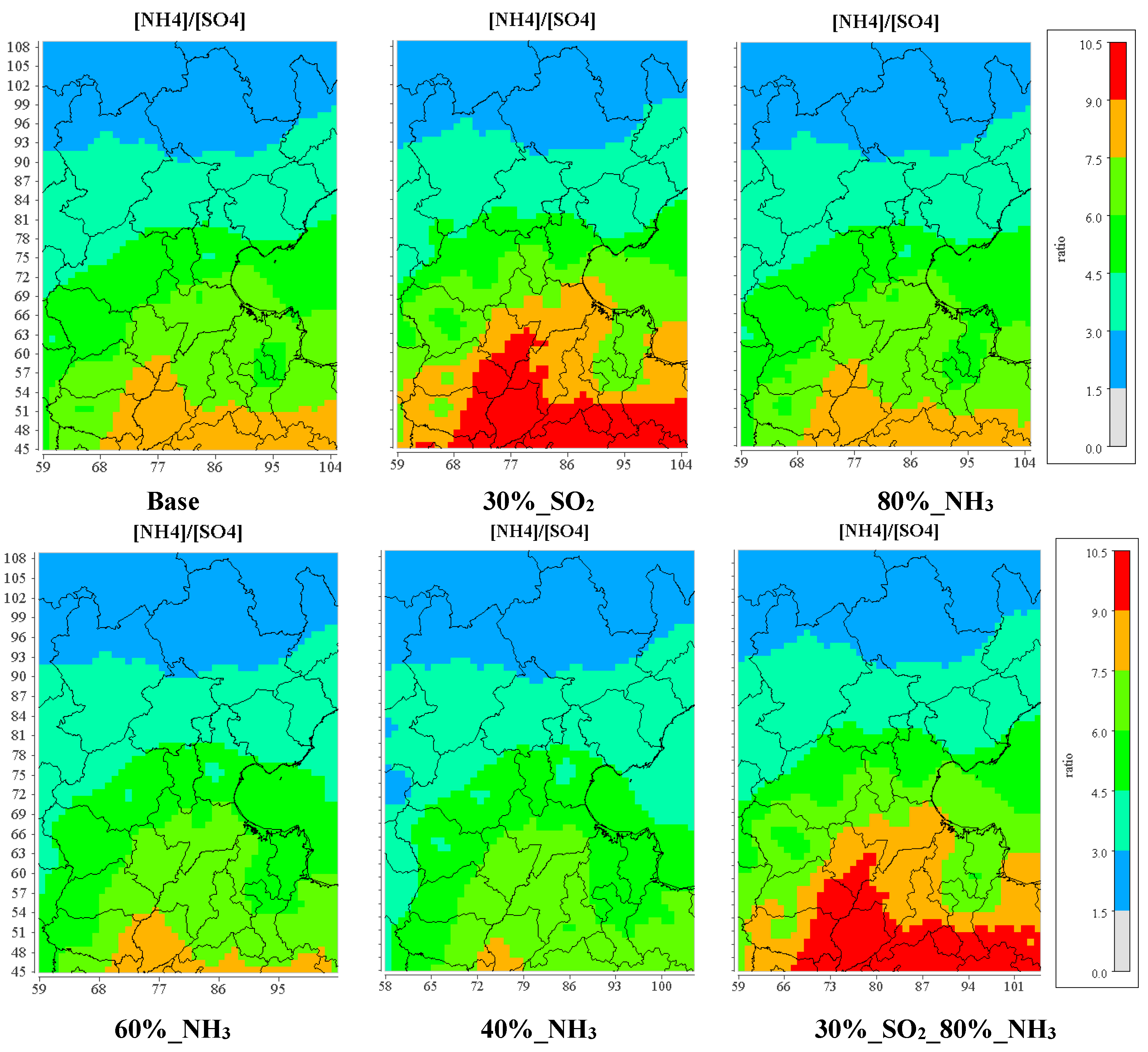
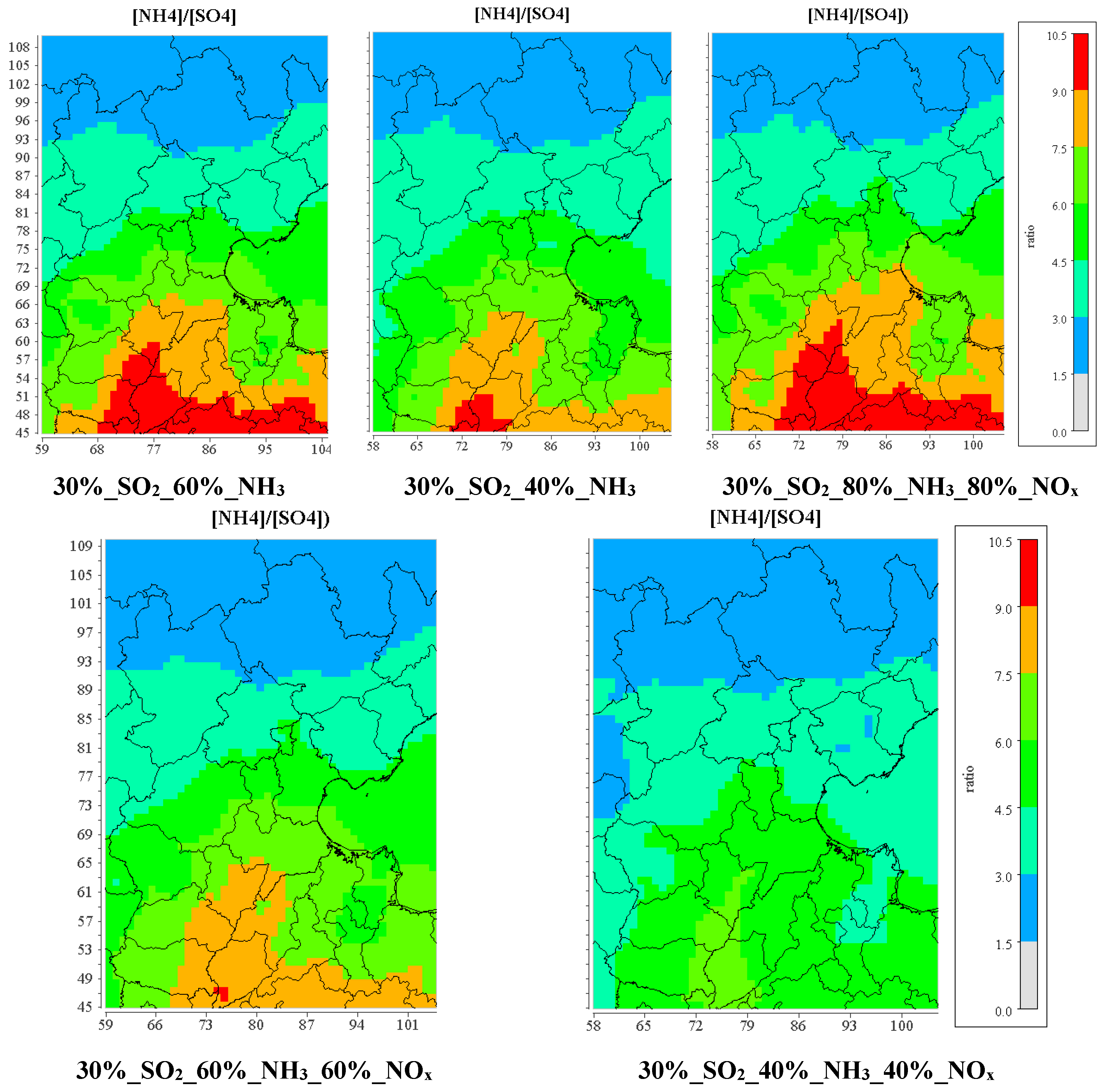
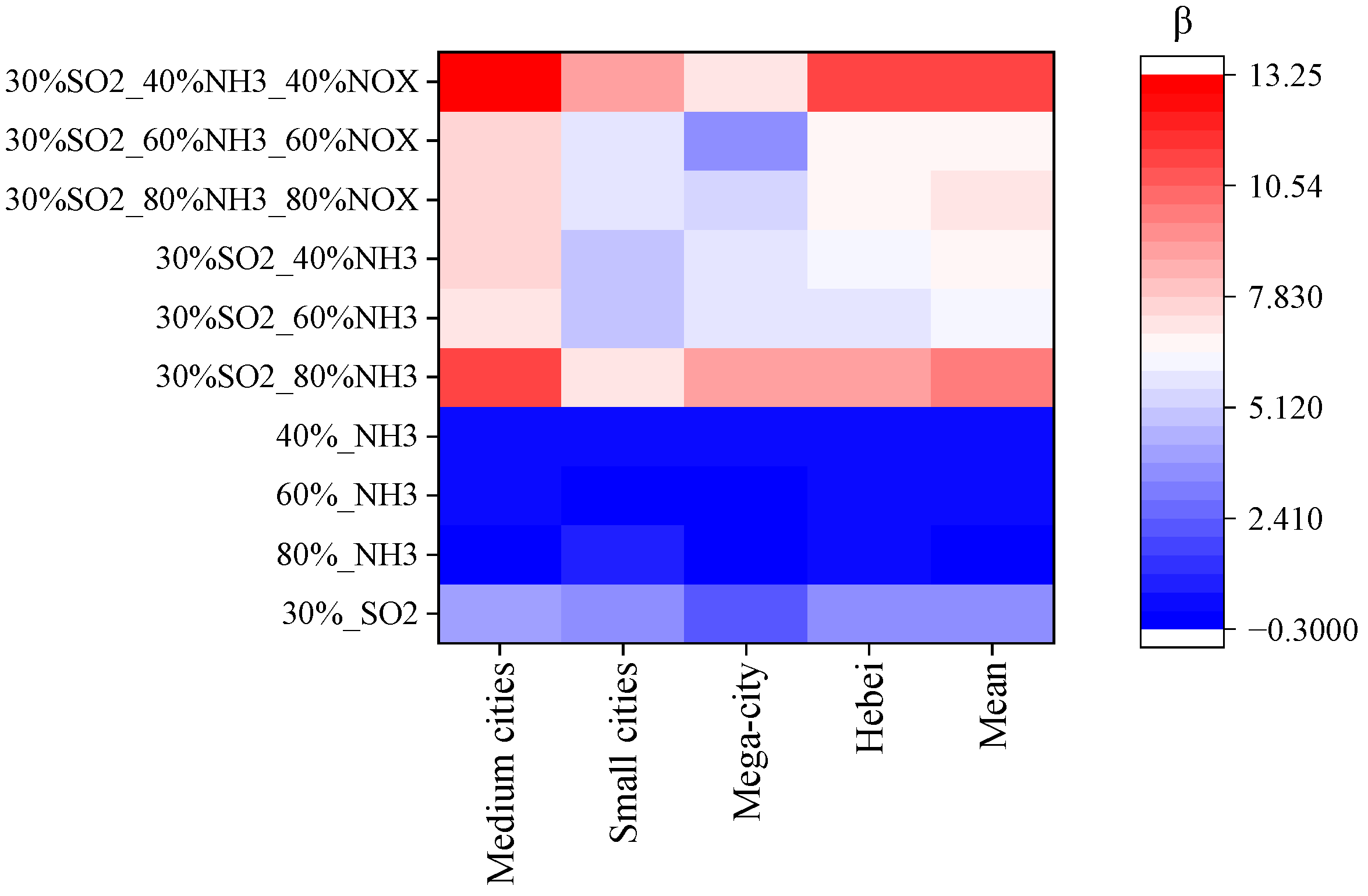

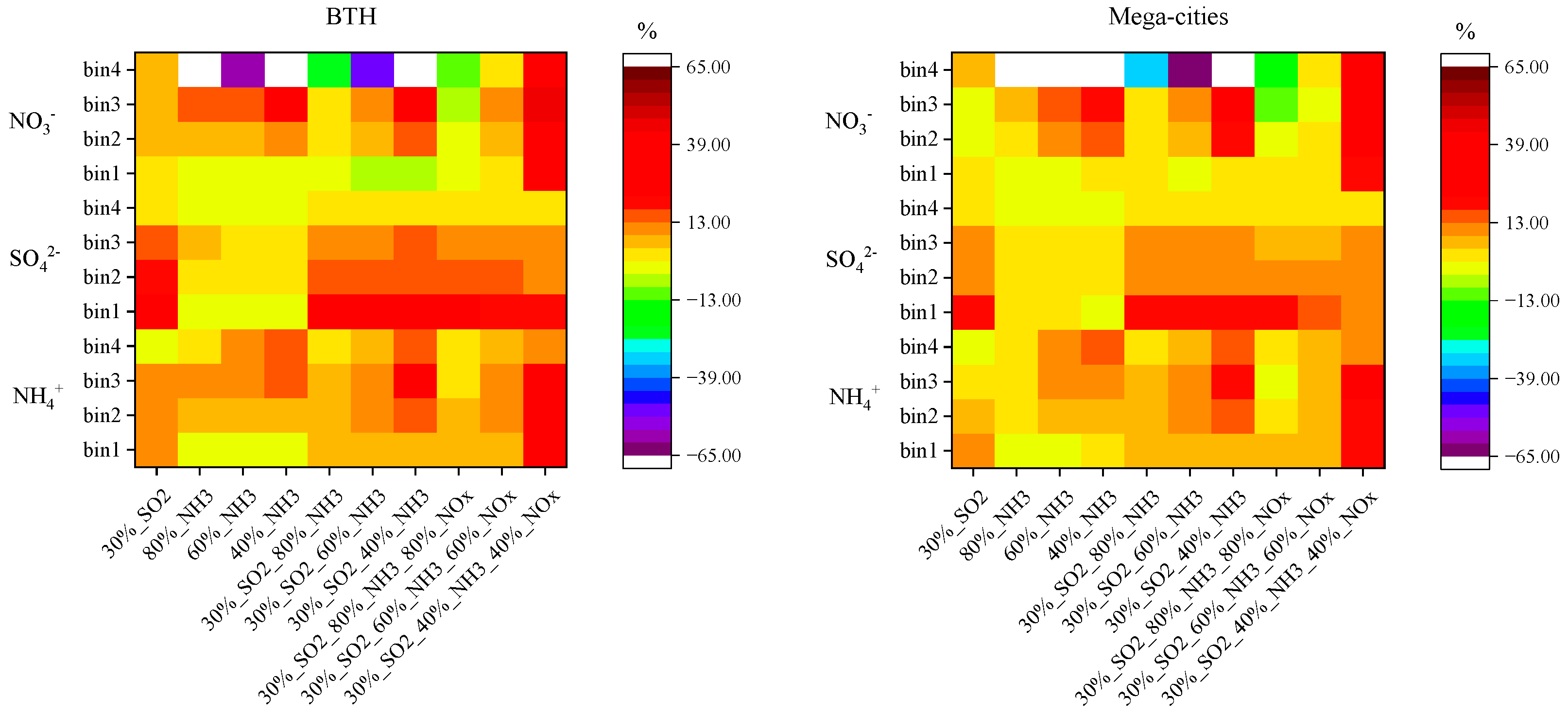
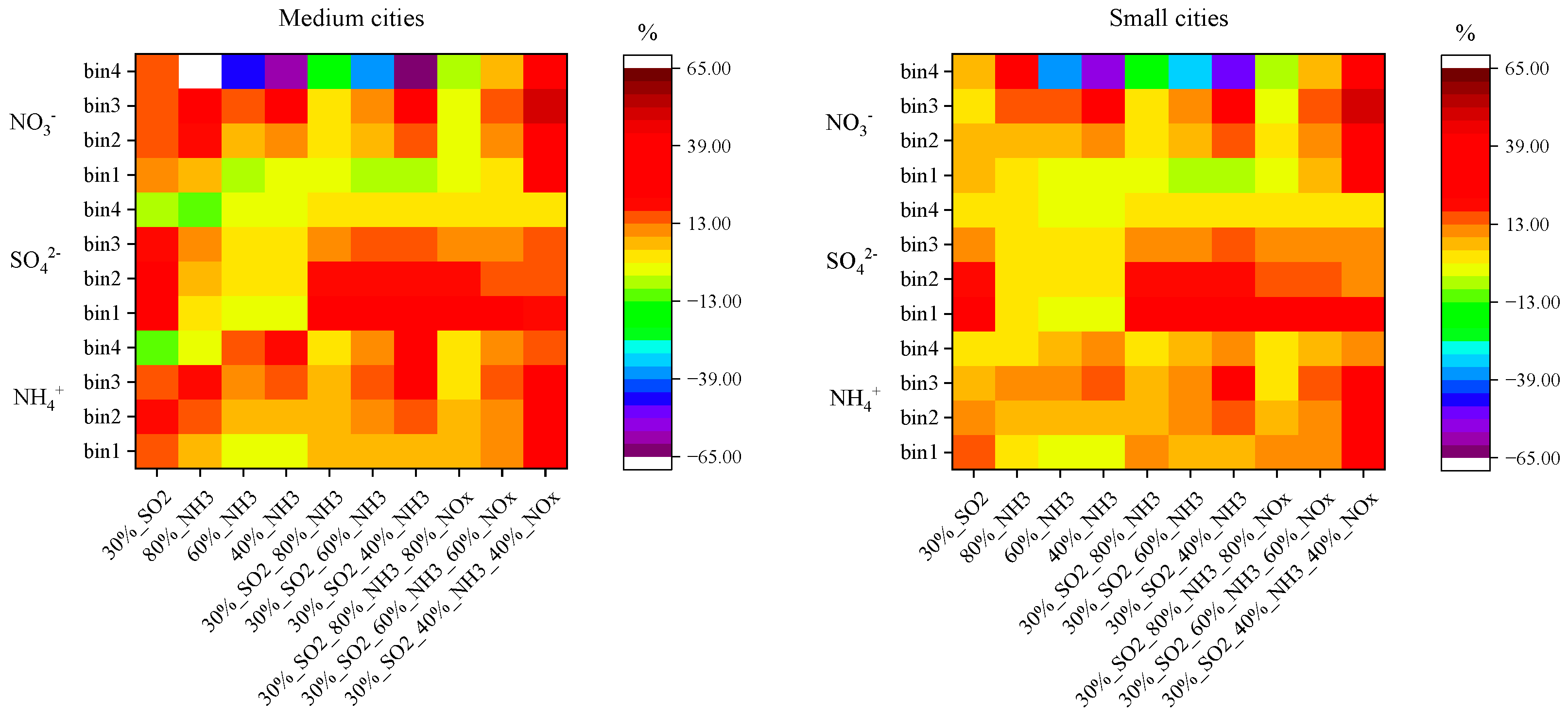
| Case Name | Period | Description |
|---|---|---|
| Base | 25 December 2015–31 January 2016 | no emission reduction |
| 30%_SO2 | 70% SO2 emission reduction | |
| 80%_NH3 | 20% NH3 emission reduction | |
| 60%_NH3 | 40% NH3 emission reduction | |
| 40%_NH3 | 60% NH3 emission reduction | |
| 30%_SO2_80%_NH3 | 70% SO2 emission reduction and 20% NH3 emission reduction | |
| 30%_SO2_60%_NH3 | 70% SO2 emission reduction and 40% NH3 emission reduction | |
| 30%_SO2_40%_NH3 | 70% SO2 emission reduction and 60% NH3 emission reduction | |
| 30%_SO2_80%_NH3_80%_NOx | 70% SO2 emission reduction, 20% NH3 emission reduction, and 20% SO2 emission reduction | |
| 30%_SO2_60%_NH3_60%_NOx | 70% SO2 emission reduction, 40% NH3 emission reduction, and 40% SO2 emission reduction | |
| 30%_SO2_40%_NH3_40%_NOx | 70% SO2 emission reduction, 60% NH3 emission reduction, and 60% SO2 emission reduction |
| Obs | Model | MB | NMB | NME | RMSE | |
|---|---|---|---|---|---|---|
| PCP24 | 17.4 | 3.0 | −14.5 | −83.0% | 104.9% | 44.1 |
| PSFC | 967.0 | 962.2 | −4.8 | −0.5% | 1.6% | 31.3 |
| Q2 | 0.0 | 0.0 | 0.0 | 2.6% | 15.9% | 0.0 |
| TEMP2 | −6.4 | −7.0 | −0.6 | −9.4% | −30.6% | 2.7 |
| WDIR10 | 214.0 | 209.0 | −5.0 | −2.4% | 33.5% | 120.1 |
| WSPD10 | 2.9 | 2.9 | 0.0 | 0.1% | 43.1% | 1.7 |
| CO | 2.1 | 2.1 | −0.1 | −3.4% | 102.7% | 4.8 |
| SO2 | 69.6 | 57.4 | −12.2 | −17.5% | 121.8% | 188.6 |
| NO2 | 54.7 | 32.9 | −21.8 | −39.9% | 77.1% | 59.3 |
| O3 | 27.6 | 26.6 | −1.0 | −3.6% | 84.8% | 29.3 |
| PM10 | 141.8 | 81.4 | −60.4 | −42.6% | 73.7% | 163.2 |
| PM2.5 | 89.6 | 78.5 | −11.1 | −12.4% | 77.3% | 133.8 |
| Obs | Model | MB | NMB | NME | RMSE | |
|---|---|---|---|---|---|---|
| PCP24 | 17.4 | 3.1 | −14.4 | −82.5% | 105.1% | 44.1 |
| PSFC | 967.0 | 966.2 | −0.8 | −0.1% | 1.0% | 22.0 |
| Q2 | 0.0 | 0.0 | 0.0 | 1.2% | 14.9% | 0.0 |
| TEMP2 | −6.4 | −6.5 | −0.1 | −1.4% | −26.5% | 2.3 |
| WDIR10 | 214.0 | 207.2 | −6.8 | −3.2% | 31.7% | 116.2 |
| WSPD10 | 2.9 | 3.0 | 0.0 | 0.9% | 40.7% | 1.6 |
| CO | 2.1 | 2.7 | 0.6 | 27.6% | 84.7% | 2.7 |
| SO2 | 69.6 | 110.6 | 41.0 | 58.8% | 117.2% | 127.2 |
| NO2 | 54.7 | 57.8 | 3.2 | 5.8% | 59.8% | 45.3 |
| O3 | 27.6 | 8.6 | −19.0 | −68.8% | 93.6% | 33.9 |
| PM10 | 141.8 | 100.0 | −41.8 | −29.5% | 57.3% | 120.9 |
| PM2.5 | 89.6 | 97.4 | 7.8 | 8.7% | 69.6% | 91.3 |
| Mega-City | Medium Cities | Small Cities | Mean | |||||||||||
|---|---|---|---|---|---|---|---|---|---|---|---|---|---|---|
| BJ | TJ | SJZ | BD | CZ | HD | LF | QHD | TS | XT | CD | HS | ZJK | ||
| 30%_SO2 | 0.6 | 1.7 | 1.6 | 1.7 | 1.7 | 1.8 | 1.1 | 1.5 | 1.1 | 1.7 | 0.9 | 1.9 | 1.3 | 1.4 |
| 80%_NH3 | −0.3 | 0.9 | 0.2 | 0.2 | 0.6 | 0.4 | 0.1 | 0.2 | 0.3 | 0.3 | −0.1 | 0.5 | −0.4 | 0.2 |
| 60%_NH3 | −0.1 | 1.7 | 0.9 | 0.4 | 2.2 | 1.5 | 0.9 | 0.4 | 0.6 | 1.3 | −0.1 | 1.9 | 0.0 | 0.9 |
| 40%_NH3 | 0.4 | 2.4 | 1.7 | 1.1 | 3.0 | 2.6 | 1.5 | 0.8 | 0.7 | 2.2 | 0.1 | 3.1 | 0.2 | 1.5 |
| 30%_SO2_80%_NH3 | 0.6 | 2.0 | 1.8 | 1.2 | 2.2 | 2.2 | 1.7 | 1.5 | 1.3 | 2.0 | 0.9 | 2.4 | 3.5 | 1.8 |
| 30%_SO2_60%_NH3 | 0.8 | 2.6 | 2.2 | 1.5 | 3.2 | 3.1 | 2.2 | 1.7 | 1.4 | 2.7 | 1.0 | 3.4 | 5.5 | 2.4 |
| 30%_SO2_40%_NH3 | 1.4 | 3.8 | 3.7 | 2.7 | 5.4 | 5.1 | 3.0 | 2.3 | 1.8 | 4.4 | 1.2 | 5.6 | 9.0 | 3.8 |
| 30%_SO2_80%_NH3_80%_NOx | 0.6 | 1.7 | 1.5 | 1.2 | 2.1 | 2.1 | 1.5 | 1.9 | 1.2 | 1.8 | 1.4 | 2.1 | 4.4 | 1.8 |
| 30%_SO2_60%_NH3_60%_NOx | 0.9 | 2.7 | 2.7 | 2.0 | 4.4 | 4.5 | 2.1 | 3.3 | 1.7 | 3.5 | 2.3 | 4.5 | 9.0 | 3.4 |
| 30%_SO2_40%_NH3_40%_NOx | 2.2 | 5.3 | 5.5 | 4.6 | 9.3 | 9.8 | 4.7 | 6.3 | 3.4 | 7.9 | 4.0 | 9.8 | 16.0 | 6.8 |
| Scenarios | NH4+ | SO42− | NO3− | NH4+ | SO42− | NO3− | NH4+ | SO42− | NO3− |
|---|---|---|---|---|---|---|---|---|---|
| Concentration (µg m−3) | Proportion in PM2.5 (%) | Decrease (%) | |||||||
| base | 6.2 | 6.5 | 13.1 | 4.5% | 4.6% | 9.4% | |||
| 30%_SO2 | 5.2 | 5.2 | 11.6 | 3.9% | 3.8% | 8.4% | 16.1% | 20.0% | 11.5% |
| 80%_NH3 | 5.6 | 6.2 | 11.5 | 4.0% | 4.4% | 8.1% | 9.7% | 4.6% | 12.2% |
| 60%_NH3 | 5.8 | 6.4 | 12.1 | 4.3% | 4.6% | 8.6% | 6.5% | 1.5% | 7.6% |
| 40%_NH3 | 5.7 | 6.4 | 11.3 | 4.0% | 4.6% | 8.1% | 8.1% | 1.5% | 13.7% |
| 30%SO2_80%NH3 | 5.7 | 5.3 | 13.0 | 4.1% | 3.9% | 9.3% | 8.1% | 18.5% | 0.8% |
| 30%SO2_60%NH3 | 5.5 | 5.3 | 12.3 | 4.0% | 3.9% | 8.9% | 11.3% | 18.5% | 6.1% |
| 30%SO2_40%NH3 | 5.1 | 5.3 | 11.0 | 3.8% | 3.9% | 7.9% | 17.7% | 18.5% | 16.0% |
| 30%SO2_80%NH3_80%NOx | 5.8 | 5.4 | 13.0 | 4.1% | 3.9% | 9.4% | 6.5% | 16.9% | 0.8% |
| 30%SO2_60%NH3_60%NOx | 5.4 | 5.4 | 11.5 | 3.9% | 4.0% | 8.3% | 12.9% | 16.9% | 12.2% |
| 30%SO2_40%NH3_40%NOx | 4.3 | 5.6 | 7.9 | 3.1% | 4.1% | 5.8% | 30.6% | 13.8% | 39.7% |
| PM2.5 | NH4+ | SO42− | NO3− | ||||||||||
|---|---|---|---|---|---|---|---|---|---|---|---|---|---|
| bin1 | bin2 | bin3 | bin4 | bin1 | bin2 | bin3 | bin4 | bin1 | bin2 | bin3 | bin4 | ||
| Base | 122.5 | 1.1 | 4.3 | 0.8 | 0.0 | 0.8 | 4.5 | 1.2 | 0.1 | 2.6 | 8.9 | 1.6 | 0.1 |
| 30%_SO2 | 119.9 | 0.9 | 3.6 | 0.7 | 0.0 | 0.6 | 3.6 | 1.0 | 0.1 | 2.3 | 7.9 | 1.4 | 0.1 |
| 80%_NH3 | 121.2 | 1.1 | 3.8 | 0.7 | 0.0 | 0.8 | 4.3 | 1.1 | 0.1 | 2.5 | 7.7 | 1.3 | 0.0 |
| 60%_NH3 | 120.6 | 1.1 | 4.0 | 0.7 | 0.0 | 0.8 | 4.5 | 1.1 | 0.1 | 2.7 | 8.1 | 1.3 | 0.2 |
| 40%_NH3 | 119.6 | 1.1 | 3.9 | 0.7 | 0.0 | 0.8 | 4.5 | 1.1 | 0.1 | 2.6 | 7.6 | 1.1 | 0.2 |
| 30%_SO2_80%_NH3 | 120.1 | 1.0 | 3.9 | 0.8 | 0.0 | 0.6 | 3.7 | 1.0 | 0.1 | 2.6 | 8.8 | 1.6 | 0.1 |
| 30%_SO2_60%_NH3 | 119.2 | 1.0 | 3.8 | 0.7 | 0.0 | 0.6 | 3.7 | 1.0 | 0.1 | 2.7 | 8.2 | 1.4 | 0.1 |
| 30%_SO2_40%_NH3 | 117.2 | 1.0 | 3.5 | 0.6 | 0.0 | 0.6 | 3.7 | 1.0 | 0.1 | 2.7 | 7.2 | 1.1 | 0.2 |
| 30%_SO2_80%_NH3_80%_NOx | 120.5 | 1.0 | 4.0 | 0.8 | 0.0 | 0.6 | 3.8 | 1.0 | 0.1 | 2.6 | 8.8 | 1.6 | 0.1 |
| 30%_SO2_60%_NH3_60%_NOx | 118.7 | 1.0 | 3.7 | 0.7 | 0.0 | 0.6 | 3.8 | 1.0 | 0.1 | 2.5 | 7.7 | 1.3 | 0.1 |
| 30%_SO2_40%_NH3_40%_NOx | 114.1 | 0.8 | 3.0 | 0.5 | 0.0 | 0.7 | 3.9 | 1.0 | 0.1 | 1.9 | 5.3 | 0.7 | 0.1 |
Disclaimer/Publisher’s Note: The statements, opinions and data contained in all publications are solely those of the individual author(s) and contributor(s) and not of MDPI and/or the editor(s). MDPI and/or the editor(s) disclaim responsibility for any injury to people or property resulting from any ideas, methods, instructions or products referred to in the content. |
© 2023 by the authors. Licensee MDPI, Basel, Switzerland. This article is an open access article distributed under the terms and conditions of the Creative Commons Attribution (CC BY) license (https://creativecommons.org/licenses/by/4.0/).
Share and Cite
Wei, Z.; Mohamed Tahrin, N. Impact of Gaseous Pollutants Reduction on Fine Particulate Matter and Its Secondary Inorganic Aerosols in Beijing–Tianjin–Hebei Region. Atmosphere 2023, 14, 1027. https://doi.org/10.3390/atmos14061027
Wei Z, Mohamed Tahrin N. Impact of Gaseous Pollutants Reduction on Fine Particulate Matter and Its Secondary Inorganic Aerosols in Beijing–Tianjin–Hebei Region. Atmosphere. 2023; 14(6):1027. https://doi.org/10.3390/atmos14061027
Chicago/Turabian StyleWei, Zhe, and Norhaslinda Mohamed Tahrin. 2023. "Impact of Gaseous Pollutants Reduction on Fine Particulate Matter and Its Secondary Inorganic Aerosols in Beijing–Tianjin–Hebei Region" Atmosphere 14, no. 6: 1027. https://doi.org/10.3390/atmos14061027
APA StyleWei, Z., & Mohamed Tahrin, N. (2023). Impact of Gaseous Pollutants Reduction on Fine Particulate Matter and Its Secondary Inorganic Aerosols in Beijing–Tianjin–Hebei Region. Atmosphere, 14(6), 1027. https://doi.org/10.3390/atmos14061027






